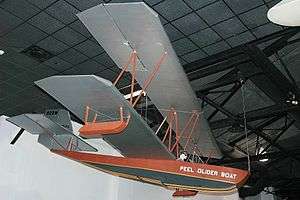Peel Z-1 Glider Boat
The Peel Z-1 Glider Boat, also called the Peel Flying Boat, is an American biplane, two-seats-in-tandem, flying boat glider that was designed and produced by the Peel Glider Boat Company, starting in about 1930.[1][2][3][4]
| Z-1 Glider Boat | |
|---|---|
 | |
| Role | Glider |
| National origin | United States |
| Manufacturer | Peel Glider Boat Company |
| Introduction | circa 1930 |
| Status | Production completed |
| Number built | 30 |
| Unit cost |
US$595 (1930) |
Design and development
The Glider Boat was intended as a strictly recreational aircraft, to be towed from the water surface by a powered boat. The company intended to produce a very inexpensive aircraft to cash in on the sudden popularity of aviation following Charles Lindbergh’s 1927 solo flight across the Atlantic Ocean.[1][3]
The aircraft is of mixed construction. The 31 ft (9.4 m) span wing has a wooden spar, steel ribs and is covered in doped aircraft fabric covering. The two wings have a large total area of 270 sq ft (25 m2) and combined with the light gross weight of 600 lb (270 kg) give a very light wing loading of just 2.2 lb/sq ft (11 kg/m2). The lower wing tips feature wingtip floats. The hull is made from duralumin and features a stepped shape, similar to most powered flying boats. The aircraft has conventional aircraft controls and was delivered without instruments.[1]
The aircraft was normally launched by a tow rope attached to the glider by a "Y" shaped bridle, with release hooks on both sides of the front cockpit. Climbing to a maximum height of 1,000 ft (305 m) as limited by the supplied tow rope, the glider would then release and glide to a landing on the water surface.[1][3]
The aircraft was placed in quantity production and sold for US$595 each. Thirty were built before the company went out of business in the Great Depression.[1][3][4]
Operational history
In August 2011 there were no Peel Glider Boats left on the US Federal Aviation Administration aircraft registry.[5]
Aircraft on display
- Cradle of Aviation Museum[4]
- EAA AirVenture Museum[3]
- National Soaring Museum[2]
Specifications (Glider Boat)
Data from Sailplane Directory and AirVenture Museum[1][6]
General characteristics
- Crew: one
- Capacity: one passenger
- Length: 22 ft (6.7 m)
- Wingspan: 31 ft (9.4 m)
- Wing area: 270 sq ft (25 m2)
- Empty weight: 250 lb (113 kg)
- Gross weight: 600 lb (272 kg)
Performance
- Maximum speed: 30 mph (48 km/h, 26 kn)
- Maximum glide ratio: 15:1 (some sources say 18:1)
- Wing loading: 2.2 lb/sq ft (11 kg/m2)
References
- Activate Media (2006). "Glider Boat Peel". Archived from the original on 29 August 2012. Retrieved 20 August 2011.
- National Soaring Museum (2011). "Sailplanes in Our Collection". Archived from the original on 16 May 2011. Retrieved 20 August 2011.
- EAA AirVenture Museum (2011). "Peel Glider Boat". Retrieved 20 August 2011.
- Cradle of Aviation Museum (2001). "Peel Z-1 Glider Boat". Archived from the original on 30 March 2012. Retrieved 20 August 2011.
- Federal Aviation Administration (August 2011). "Make / Model Inquiry Results". Retrieved 20 August 2011.
- EAA AirVenture Museum (2011). "Peel Glider Boat Specifications". Retrieved 14 August 2011.